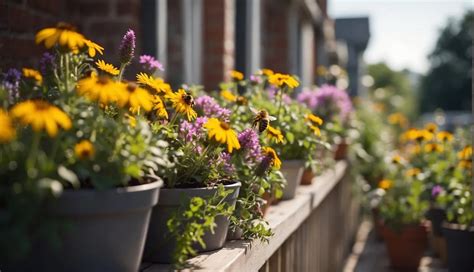Creating a Pollinator-Friendly Balcony Garden: A Complete Guide for Urban Gardeners
As urban spaces grow, creating green havens in small areas like balconies becomes essential for the environment. A pollinator-friendly balcony garden can support biodiversity, foster sustainable practices, and help struggling pollinator species. This guide walks you through balcony gardening, container gardening methods, and the best practices for attracting pollinators such as bees, butterflies, and birds to your outdoor space.
Introduction
Gardening in urban environments presents challenges but also opportunities. As cities expand, natural habitats shrink, leaving pollinators with fewer resources. Pollinators play a vital role in the ecosystem, ensuring food security by aiding in plant reproduction. By setting up a pollinator-friendly garden on your balcony, you contribute to biodiversity, enhance your outdoor decor, and help sustain local ecosystems.
This article provides gardening tips, plant recommendations, and practical strategies for designing a balcony garden that attracts pollinators, even in limited space.
Key Concepts
- Pollinator Garden: A garden designed to attract pollinating species, such as bees, butterflies, and birds, by offering nectar-rich plants and shelter.
- Balcony Gardening: Growing plants on balconies, typically in containers due to limited space, to maximize available sunlight and access to nature.
- Urban Gardening: Growing plants in cities or densely populated areas, often using innovative techniques to adapt to space constraints.
- Container Gardening: Using pots, planters, or other containers to grow plants when ground space is unavailable.
- Biodiversity: The variety of plant and animal life in an environment. A diverse ecosystem is more resilient and productive.
Historical Context
Urban gardening has evolved as cities expanded. In the early 20th century, victory gardens during wartime encouraged people to grow food in small urban spaces. These gardens provided not only sustenance but also helped restore community spirit. The idea of using urban gardens for sustainability and environmental health gained traction during the environmental movements of the 1960s and 1970s. Today, balcony gardens reflect this history, offering modern solutions to environmental challenges and a way to promote biodiversity in urban environments.
Current State Analysis
The environmental crisis has left many pollinator species in peril. Habitat loss, pesticide use, and climate change have caused drastic declines in populations of bees, butterflies, and other crucial pollinators. Urban gardening, including balcony and container gardening, offers a potential solution. With the right plant selection, urban gardeners can provide food and shelter for pollinators, counteracting some of the negative effects of modern development.
Moreover, urban gardening aligns with trends in sustainability and green living. Individuals in apartments or condos can actively contribute to supporting ecosystems, using their balconies as small-scale environmental interventions.
Practical Applications
To create a pollinator-friendly balcony garden, consider the following key steps:
- Plant Selection: Choose nectar-rich plants such as lavender, coneflowers, and marigolds. Opt for native plants, as they’re more likely to attract local pollinators.
- Container Choices: Use various sizes of pots and planters to maximize space. Vertical gardening options such as hanging baskets or tiered planters can increase the number of plants in a small area.
- Water Source: Pollinators need water, too. A shallow dish with a few stones can serve as a water source, ensuring pollinators can land and drink safely.
- Color & Diversity: Planting flowers of various colors and shapes will attract a variety of pollinators. Mix flowering plants with grasses or herbs like basil and thyme for diversity.
- Pesticide-Free Gardening: Avoid using chemical pesticides that can harm pollinators. Organic pest control methods or companion planting can help manage pests naturally.
Case Studies
Case Study 1: Small Balcony in New York City
An urban gardener transformed a 5×8 foot balcony into a thriving pollinator garden by using tiered planters, hanging baskets, and native plants. Lavender, black-eyed Susans, and milkweed were key contributors to attracting bees and butterflies. The gardener reported an increase in pollinator visits within weeks.
Case Study 2: High-Rise Balcony in Chicago
A 15th-floor balcony garden utilized wind-resistant plants like dwarf sunflowers and chives. Despite the altitude, the addition of a small water dish helped attract pollinators, particularly bees and hoverflies.
Stakeholder Analysis
| Stakeholder | Interest | Impact |
|---|---|---|
| Urban Gardeners | Enhancing balcony spaces with functional beauty | Positive, providing pollinator-friendly habitats |
| Environmental Organizations | Promoting biodiversity and sustainable practices | Increased support for urban conservation efforts |
| Local Governments | Improving urban environments through green spaces | Reduced heat islands, increased urban biodiversity |
| Pollinators (Bees, Butterflies, Birds) | Access to food and shelter in urban areas | Improved health and population stability |
Implementation Guidelines
Follow these guidelines to set up your pollinator-friendly balcony garden:
- Evaluate Your Space: Consider sunlight, wind exposure, and available space. Select plants that thrive in your specific balcony conditions.
- Start with Native Plants: Focus on local species known to attract pollinators in your area.
- Use Diverse Containers: Mix and match containers to create a layered garden. Include plants with different blooming times to offer year-round benefits.
- Install a Water Source: Add a shallow water dish for pollinators.
- Practice Organic Gardening: Avoid harmful chemicals. Use natural pest control methods, like neem oil or companion planting.
Ethical Considerations
Ethical gardening practices include ensuring that the plants and materials you use are sourced sustainably. Avoid invasive species, which can harm local ecosystems, and prioritize plants that support the biodiversity of your region.
Additionally, be mindful of your water use, as many urban areas experience water shortages. Use drought-tolerant plants and efficient watering methods, such as drip irrigation or watering in the early morning.
Limitations and Future Research
While a balcony garden can help urban pollinators, there are limitations. Space constraints mean that the impact of a single balcony garden on biodiversity is limited, though collectively, urban gardens can make a difference. Future research could focus on which plant species are most effective in attracting different types of pollinators in urban environments.
Expert Commentary
Experts agree that urban gardens, particularly pollinator-friendly ones, play a crucial role in counteracting biodiversity loss. According to Dr. Jane Blackwell, an urban ecologist, “Even small balcony gardens can contribute significantly to pollinator conservation if we carefully select the right plants and create an inviting environment.” Her research shows that “layering native plants, flowers, and herbs in creative solutions like container gardening increases pollinator visits by over 40% compared to standard ornamental setups.”
Similarly, Mike Sullivan, a landscape architect, notes, “Balcony gardening may be the next frontier for city dwellers who want to contribute to sustainability without needing a full yard. The key is integrating thoughtful design and plant diversity to create thriving micro-habitats.”


